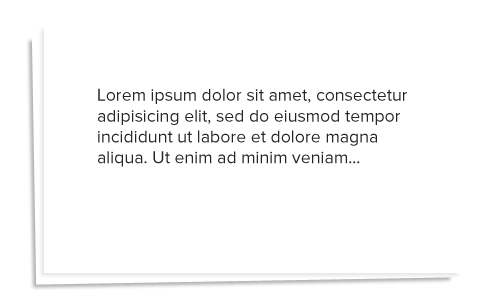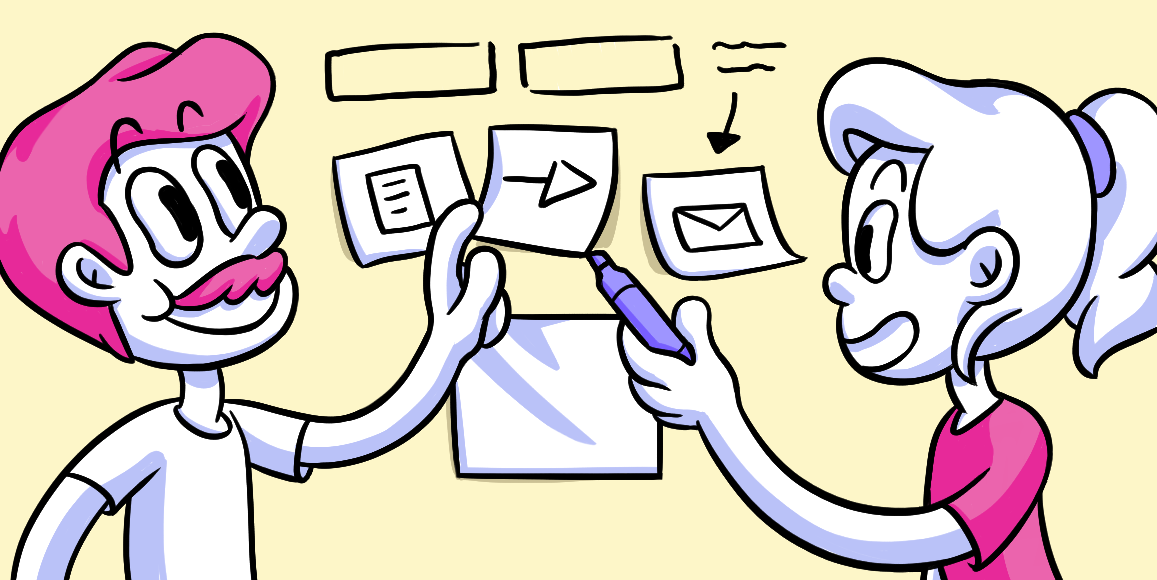Lorem Ipsum
Dummy text is for dummies. Stop relying so much on lorem ipsum.
The nuts and bolts: Lorem ipsum is a placeholder text often used in design to display the visual shape of a document or typeface without relying on significant content. It’s a lazy way to design before the final copy is available.
Picture this: a beautiful design concept with a clear visual hierarchy and perfectly intuitive navigation. Everything looks great, and you’re congratulating yourself already on the most excellent partnership that you’ve developed with your designers. But as you begin to read the content on the page, you realize something’s off:
It’s all dummy text! And as a client, this should throw up a red flag for you. When designers use lorem ipsum to fill content, it means that they don’t know what the real content should be. And that’s actually a really big problem.
What is lorem ipsum?
Commonly used as placeholder text in graphic design and publishing, lorem ipsum plays a significant role in design and typeface history. You’ll see this nonsensical Latin derivative anywhere there’s text, but the meaning of that text is not really important. The idea behind lorem ipsum is that when you are trying to preview a design, it’s hard to visualize how the content will look on the page. Thus, in the preliminary stages of designing, designers will use lorem ipsum – from a distance it looks just like real text, and it’s a helpful way to compare different typefaces and envision large blocks of content.
So, what’s the problem?
Lorem ipsum is a cheap substitute for the real thing: meaningful, compelling text that drives your website. However, the problem is that so many designers seem to forget that. The primary purpose of a designer is to convey content in an innovative and visually compelling way. And it’s kind of hard to do this when you don’t even know what your content is. Content should drive design, not the other way around.
When you’re designing without content, whatever design you create is ultimately meaningless, no matter how elegant. It’s okay not to have all the details fleshed out, but you’ve got to have some idea of what the text is going to be. And that’s what should fill your page.
And when you come to think of it, designing before any writing is a pretty counterintuitive process. Even if you know what you’re going to write about, you don’t know how long your content will be. What if you chug out a couple short paragraphs and realize you haven’t got anything more to say on the topic? Or, on the other hand, what if you realize – three pages later – that perhaps what started out as a subsection probably needs its own heading?
People seem to underestimate the value of content. You can’t build a website on empty cells and structures while simultaneously hoping to capture the business intent of your product. Your content lets you communicate the true meaning of your website … so don’t treat it as an afterthought! There’s no reason for lorem ipsum to see the light of day once the very basic groundwork of a new design is laid. It’s a sign that your designer has lost interest in meaning, your writer has been pressed with unreasonable goals and your leader has you charging to a goal that is at best mediocre. Let content drive your design. If you’re not prioritizing what you’re saying, what makes you think your customers will?
So, Write First and then Design?
So we’ve basically said that lorem ipsum should be ousted out of the design process. Does that mean that you need to have all your content written and done before the design process? We know that’s not always doable, especially when working with clients that have their own priorities. And under those conditions, we understand that lorem ipsum is sometimes unavoidable. While the content is being worked on, the clock is ticking. Sure, you could wait until the eleventh hour so that you get the content, and then start designing, but all nighters are no fun. Plus, that’s just another extreme. Designing and writing are not mutually exclusive, contrary to what the industry might suggest. Rather than trying to accommodate content to fit within the constraints of your design, it’s much better to understand designing and writing as collaborative and concurrent processes.
Ideally, the designer and writer should be working together to develop a great final product. A great example of this was during ZURBwired 5. Given the 24-hour time crunch, our designers and content writers worked in tandem and collaborated constantly with one another in order to quickly and efficiently produce the best possible online experience and print materials. With our Editor and writers working with the web design and visual design team on the Family Giving Tree’s new website, we were able to marry content with design in a harmonious way. And within such a partnership, there is no reason to use lorem ipsum. Sounds perfect, right?
If Only It Were So Easy
Unfortunately, the real world doesn’t always operate so smoothly. Sometimes, factors like hard deadlines, financials and sheer geographical distance make it nigh impossible for writers and designers to work alongside each other. And that’s why lorem ipsum still lives.
Here are a few ideas for both writers and designers to take into consideration during the design process that will make collaboration easier and limit the amount of lorem ipsum on the page.
Your role doesn’t define you. Just because you’re the designated designer for the project at hand, doesn’t mean that you can’t do anything else. Get a feel for type of content that the project calls for by doing some free writing of your own. This will give you great insight into your colleagues’ responsibilities and help you to better collaborate with them. Same for writers and editors — feel free to send your designers sketches of some wireframes based on your content. They’ll appreciate your interest and the wireframes will give them a better idea of how you want to visually structure the content.
Be flexible. This is a team effort. Don’t send your absolute pixel perfect final draft to your colleagues two days before the deadline and then be disappointed when your work gets chopped up and is hastily incorporated into everyone else’s work. Instead send them something that is more versatile. For designers, this means using flexible frameworks to code up a page. For editors, this means creating content that can be made more concise or elaborated upon easily.
Iterate constantly. Collaboration is the name of the game here, folks, and even if you can’t work alongside your team, you can certainly regularly update them on your progress. Don’t aim for a polished final product — it’s probably going to get changed anyways. Rather, send periodic updates on your content or designs that your colleagues can incorporate into their own work. This is the best way to minimize the impact of lorem ipsum: by iterating constantly, your colleagues are up-to-date on your progress and can use your work to drive their own innovations, creating a healthy and efficient partnership.
Get feedback from clients and colleagues. When you’ve drafted some content, ask your colleagues and clients to take a look at it. Ask them if you’re on the right track or if they had something entirely different in mind. This is really helpful because it guarantees that early on everyone is on the same page and open avenues for other sources of creative inspiration. Sure, it can be scary or even uncomfortable to ask for feedback (after all, you know your own field best, right?) but you’re not working in a vacuum. Getting input from different people ensures that the final product is representative of the entire team.
Hopefully, those tips will point you in the right direction. Using lorem ipsum can derail your project and negatively impact your client’s web experience, because it clearly indicates that you’re prioritizing design over content. But unfortunately, we live in a world where sometimes lorem ipsum is inevitable. In such situations, it is best to collaborate and iterate with colleagues in a cooperative process where design and content develop together. And both designers and writers live happily ever after.
Get feedback on your messaging from your target audience with this easy to use Helio Test Template:


















